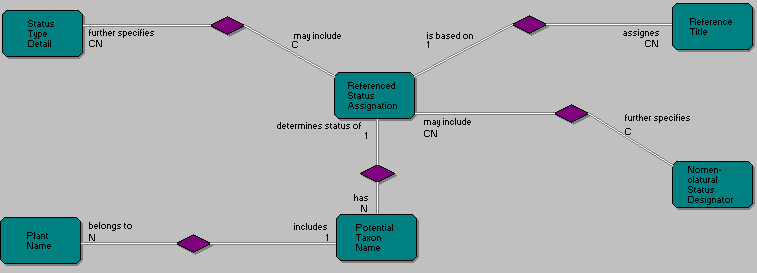
Linking non-taxonomic data to taxa is an implicit idea of any botanical database. However, the object of the link, the taxon, provides for an astonishing amount of innate problems. The commonly used identifier for a taxon is its name, but the same name may be applied to different, non-congruent concepts of a taxon. The difference may range from outright misapplication of a name to slight disagreements on the circumscription of a taxon (i.e., its separation from other taxa). This is not accidental, but rather a direct consequence of the rules of botanical nomenclature (see article 47.1. in the Tokyo Code, Greuter & al., 1994).
Since herbarium specimens and field observations are the base for grouping plants into taxa, the 'cleanest' approach to link data to taxa would be to link them via designated voucher specimens. This makes the data independent of the taxon concept of a particular taxonomist. However, although providers of data should actively be encouraged to collect and deposit vouchers, building the information system on this approach is impractical at this point of time, for the following reasons:
The data model for a global plant information system must be kept open to link in specimen information, be it to document the taxonomic decisions taken, or to be used as vouchers for the identification of plants found to have, for example, interesting phytochemical properties. Moreover, to avoid the problems inherent in directly linking plant information to taxon names, a representation of the taxon concept must be implemented in the database.
As outlined above, the circumscription of a taxon may vary from one author to another, the system the authors adhere to may be different, and there does exist a huge amount of information about plants which is linked to invalid names, synonyms, or misapplied names. The data model must allow to preserve these different concepts and document the errors. In a system which will be build, at least initially, from data imported and converted from existing databases, it is particularly important that the editing process works on data in the database rather then requiring evaluation of the information at the time of data input. Thus, a simple merging process on the information linked to a taxon name does not work. Several name-items have to be allowed for, which may carry the same name but which are used in conjunction with a reference citation identifying the concept of the taxon implied. These "Potential Taxa" (Berendsohn, 1995) form the central linkage point for all information about plants in the IOPI model and related botanical information models which have been developed over the last years.

Diagram 1: Basic datastructure of botanical information
According to Diagram 1, a potential taxon consists of:
Directly linked information, which is referred to the same reference as the potential taxon, includes:
Information which is linked to a potential taxon, but which may have a source reference different from the circumscription reference (see chapter 7), which includes:
Arguably, certain nomenclatural information such as validity, basionym and type data should be linked to the plant name rather than to a potential taxon name. However, although ultimately there should be only a single correct view, the actually published information is error prone. The database is to document different opinions (as well as errors) as part of the investigative process. Thus, such information cannot be linked to a plant name, where it would be overwritten in the correction process.
In the model, every name with an acceptable structure (see next chapter) represents a potential taxon, even if the only circumscription reference is the author or presumed author of the name itself.
The following diagram depicts the entities directly involved in the definition of potential taxa. The detailed structure of botanical names is described in chapter 2, the different possibilities for status assignations are given in chapter 3, and systematic relationships in the sense of classifications are given in chapter 4.

Diagram 2: Potential taxa and their status assignation
Next chapter; Contents of this article; Complete entity list; References cited; Author information. Last updated: June 23, 1995